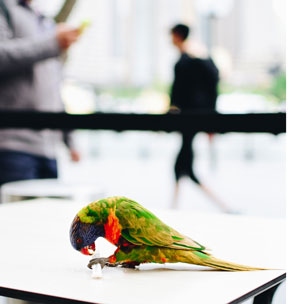Inner-city residents like the bright lights, the energy, the community, and the convenience of life in the centre of things. But, as Spencer & Servi real estate agents know well, these central sophisticates like their tree-lined streets, and their little parks and their gardens too, and the native birds that flock to them, given the right conditions.
Sydney is full of introduced pest birds – pigeons, starlings, common or Indian mynas – with the yellow beaks and eye patches (not noisy miners, the small grey native birds, extraordinarily brave and aggressive and happy to attack other birds four or five times their size).
But there are plenty of native birds too, even in the inner city, especially for those lucky few who live near the big parks – Centennial Park or Sydney Park. Those noisy miners, currawongs, magpies with the beautiful voices, rainbow lorikeets, willy wagtails, magpie larks, screeching sulphur-crested cockatoos, even the delicate little fairy wrens: they’re here in the city if you look keenly.
To encourage native birds in your inner-city courtyard or garden, plant shrubby native species or native grasses they will like to eat, nest in, or take cover in. A native community plant nursery, like the Randwick Council nursery in Barker Street, Kingsford, will be able to help you choose the right species for your area and the conditions prevalent in your garden.
Some native birds feast on blossoms – say gumtree flowers, or bottlebrush, or wattle, or grevillea. Others eat the insects attracted by the native shrubs, or seeds produced by them.
Introduced pests usually feed differently – the ubiquitous Indian myna, for instance, now seen everywhere across the city, likes exotic date palms and pencil pines, and will happily tuck into a bowl of cat or dog food if it’s left out.
Although most experts say it’s not a good idea to feed native birds, even with the commercial stuff sold especially to tempt, say, a few of the gorgeous multi-coloured rainbow lorikeets to drop in for a spell, it’s perfectly fine to install a birdbath, which will become a bird drinking station as well.

It could be a purpose-built birdbath on a pedestal, or simply a large flat ceramic saucer from a big pot-plant, filled with water and left up high on an outdoors table on a deck, or on a shelf. Currawongs might like to pop in for a drink. Those pushy noisy miners will come for a big wash, splashing water all over the place.
It’s important to make sure cats can’t get at it, and to refresh the water every now and then (don’t let it get so polluted that bugs, like mosquito larvae, will start growing in it).
If you have a cat, keep it indoors, at least at night, and preferably all the time. Cats just can’t help it: they are natural-born hunters of just about anything. It’s bad enough when they bring you home a dead mouse, but a dead bird is just horrible – a sad little pile of bloodied feathers.
It’s not only birds (both native and exotic) that most cats will happily hunt and kill, they will go for lizards, rodents and just about any small and defenceless native mammal that’s small enough to tackle.
in Latest News
Share This Post
Categories
Archived Posts
- February 2024 (1)
- January 2024 (2)
- October 2023 (2)
- September 2023 (1)
- August 2023 (3)
- July 2023 (2)
- September 2021 (1)
- August 2021 (3)
- November 2019 (1)
- October 2019 (4)
- February 2018 (1)
- January 2018 (1)
- December 2017 (3)
- November 2017 (1)
- October 2017 (2)
- September 2017 (4)
- August 2017 (4)
- July 2017 (2)
- June 2017 (1)
- May 2017 (1)
- April 2017 (1)
- March 2017 (1)
- February 2017 (1)
- January 2017 (2)
- December 2016 (2)
- November 2016 (1)
- September 2016 (1)
- July 2016 (1)

